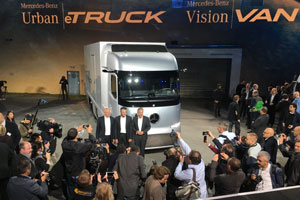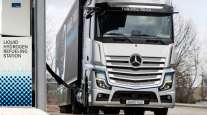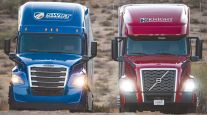Daimler Targets Urban Uses With Electric Concept Vehicles

This story appears in the Sept. 26 print edition of Transport Topics.
HANOVER, Germany — Daimler Trucks presented three electric concept vehicles ahead of the IAA commercial vehicles show here, signaling a focus on urban transportation.
The Mercedes-Benz Urban eTruck, Vision Van and Future Bus will make urban transportation “more efficient, safer and connected,” said Wolfgang Bernhard, head of Daimler Trucks’ global truck and bus division.
“In the coming 10 years, more will change in our vehicles than in the past 120 years,” Bernhard said.
MORE ON IAA: Neil Abt on Sirius XM, Sept. 26, 2 p.m. EDT
The result, he said, “is making cities a better place for everyone.” That is critical, he added, because studies show an estimated 70% of the world’s population will reside in urban areas by 2050.
Daimler’s event at a power plant here Sept. 20 took place the evening before the start of IAA, the biennial truck show that tends to feature technologically advanced commercial vehicles.
At the previous IAA, in 2014, Daimler showcased its autonomous Mercedes-Benz Future Truck, which Bernhard called a vision for longhaul transport.
For this show, however, the company zeroed in on a three-part strategy to address the growing need to improve efficiency and environmental aspects of transportation for cities worldwide.
Bernhard said the Urban eTruck offers a range of 200 kilometers (124 miles) and utilizes a lithium- ion type battery. It generates zero emissions and made little noise during a short outdoor demonstration.
It continually monitors the battery power and delivery route, and has the ability to operate in three modes to provide additional power or reduce torque if there is unexpected traffic. It would take no more than two hours to fully charge the battery, and drivers would have the ability to schedule an intermediate charging at a delivery stop to gain additional energy.
In a Sept. 21 meeting with reporters, Bernhard said that in the past, he had believed there was no real market for electric trucks. However, in recent years, the push for better battery technology from smartphone makers has changed the dynamic and sparked rapid advancements.
The result is better performance in vehicle applications, making it possible to develop trucks for short hauls on electric power.
While the European market is more suited for electric vehicles, where hauls are often shorter, U.S. cities are a bit more spread out and less densely populated, meaning it will likely take longer for them to gain significant traction in the United States.
The Vision Van is part of an expanded strategy to provide enhanced last-mile delivery, which “is the majority of the total delivery cost,” said Volker Mornhinweg, head of the Mercedes-Benz van division.
The futuristic van features a fully automated cargo space, integrated drones for autonomous air deliveries and joystick control. It, too, is emission-free and has a virtually silent electric drive system to allow for late night same-day deliveries in residential areas.
Besides displaying the van, Mornhinweg shared details of the company’s “adVANce” initiatives as drones flew overhead and small robots exited the van, simulating actual deliveries.
Mornhinweg said Daimler plans on offering an electric van in 2018.
Meanwhile, the Future Bus utilizes “CityPilot,” an adaptation of the Highway Pilot system that is the basis of Daimler’s autonomous trucks. The company said CityPilot can drive safely through intersections equipped with traffic lights, detect pedestrians on the road and automatically brake in response to them. It also can drive up to bus stops, open and close doors automatically, and even drive through tunnels.
Bernhard acknowledged the price tag for the eTruck “would be considerably higher than that of a conventional truck.”
However, he said that in the coming years, production costs would fall significantly and batteries will become more affordable. Additionally, he said higher purchasing costs could be offset by lower operating and maintenance costs, noting that electricity is about 40% less expensive than diesel.




